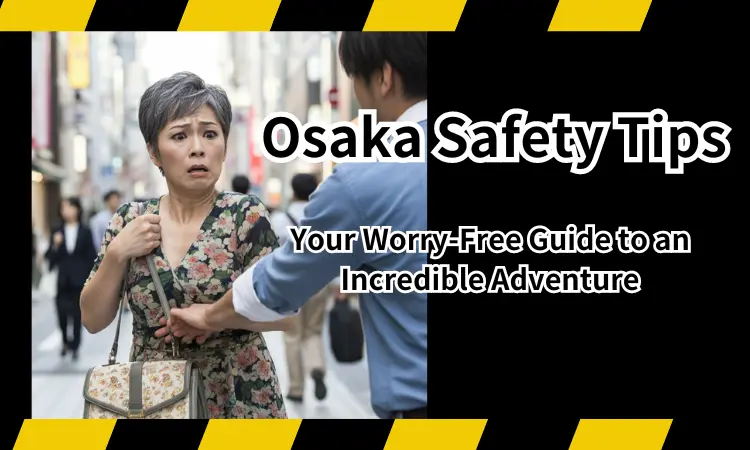Osaka Safety Tips: Your Worry-Free Guide to an Incredible Adventure
Osaka, the vibrant heart of Japan’s Kansai region, is a city that thrives on its unique blend of traditional culture and modern innovation. It’s a place where ancient shrines stand side-by-side with towering skyscrapers, and where the aroma of street food fills the air. While Osaka is generally considered one of the safest cities in the world, being aware of some key safety tips will ensure you have a smooth and enjoyable trip. Let’s explore how you can make your journey safe, comfortable, and memorable.
Understanding the City Layout and Transportation
- Osaka’s Major Areas and Districts: Osaka is a sprawling metropolis, but most of its attractions are concentrated in a few key areas: Umeda (Kita), Namba (Minami), and Tennoji. Umeda is known for its bustling business district and shopping malls, while Namba offers a vibrant nightlife and famous street food. Tennoji boasts historical landmarks like the Shitennoji Temple. Each district has its unique charm, but it’s important to stay aware of your surroundings, especially in crowded areas where pickpocketing can occur.
- Public Transportation Safety: Osaka’s public transportation system, including the extensive train and bus network, is efficient and safe. However, rush hours can get extremely crowded, so keep your belongings secure and avoid peak travel times if possible. Taxis are reliable, and you can hail one from designated stands or use official apps to ensure a safe ride.
General Safety Tips
- Personal Safety: While crime rates are low in Osaka, it’s wise to take basic precautions. Keep your valuables close, preferably in a front pocket or a crossbody bag. Avoid displaying large amounts of cash or expensive items, especially in busy areas. When walking at night, stick to well-lit streets and avoid isolated areas.
- Emergency Contacts and Services: In case of an emergency, dial 110 for police and 119 for fire and ambulance services. The Osaka Tourist Information Center and local police stations often have staff who can speak English and assist you if needed. Keep these numbers handy and know the location of your nearest police station.
Cultural Etiquette for Safety
- Respecting Local Customs: Understanding local customs can prevent misunderstandings and potential conflicts. For example, in Osaka, it is customary to queue politely and wait your turn, whether you are waiting for a train or at a restaurant. Raising your voice in public is considered rude, so maintain a calm demeanor even in stressful situations.
- Appropriate Behavior in Public Spaces: When using public transportation, avoid speaking loudly or using your phone. Respecting the peace and privacy of others is a fundamental part of Japanese culture. Also, remember that eating while walking is generally frowned upon, so take a break and enjoy your food while sitting.
Weather and Natural Disaster Preparedness
- Weather Conditions and Tips: Osaka experiences hot, humid summers and mild winters. If you’re visiting during summer, stay hydrated, wear lightweight clothing, and use sunscreen to avoid heatstroke. Check the weather forecast regularly, especially during the typhoon season (June to October), and have a small umbrella or raincoat handy.
- Earthquake and Tsunami Preparedness: Japan is an earthquake-prone country, and Osaka is no exception. Familiarize yourself with basic earthquake safety measures, such as hiding under a sturdy table and moving away from windows. Know your nearest evacuation points and consider downloading a reliable earthquake alert app.
If you are in Umeda during an earthquake, extra caution is necessary. Umeda is a low-lying area, making it vulnerable to flooding from tsunamis or the Yodogawa River. The underground shopping areas in Umeda are particularly at risk of severe flooding. If you find yourself in Umeda when an earthquake occurs, remember to evacuate to the upper floors of the nearest tall building!
Health and Medical Information
- Hospitals and Clinics for Foreigners: Osaka has several hospitals and clinics catering to foreign visitors, such as Osaka University Hospital and Nakanoshima Hospital. These facilities often have multilingual staff and accept foreign insurance. Keep a list of these hospitals and their contact information in case of illness or injury.
- Pharmacies and Emergency Medications: Pharmacies, or “yakkyoku,” are common in Osaka. Most medications, including over-the-counter drugs for headaches or stomachaches, can be found here. If you need something specific, ask the pharmacist for assistance or show a picture of the medicine.
Local Scams and How to Avoid Them
- Common Tourist Scams in Osaka: Though rare, some scams target tourists in Osaka. Be cautious of overly friendly strangers offering unsolicited help or invitations, and avoid unlicensed tour guides. When dining or shopping, ensure prices are clear to avoid being overcharged.
- How to Report Incidents: If you find yourself a victim of a scam, report it immediately to the local police. They are approachable and will guide you through the process. Additionally, contact your embassy for further assistance.
Digital Safety Tips
- Using Public Wi-Fi Safely: Osaka offers free public Wi-Fi in many locations, but it’s important to use it wisely. Avoid accessing sensitive information, like banking details, over public networks. Use a VPN to secure your connection and ensure your data stays safe.
- Protecting Personal Information: Be mindful of where you store personal documents, like your passport and credit cards. Consider using a hotel safe or a secure pouch. Avoid sharing too much personal information online or with strangers.
Conclusion
As you explore the vibrant streets, historic sites, and delicious eateries of Osaka, remember to stay aware and follow these safety tips. With a bit of preparation and awareness, you can enjoy a safe, enjoyable, and unforgettable experience in this remarkable city. Travel smart, stay safe, and embrace all that Osaka has to offer!









